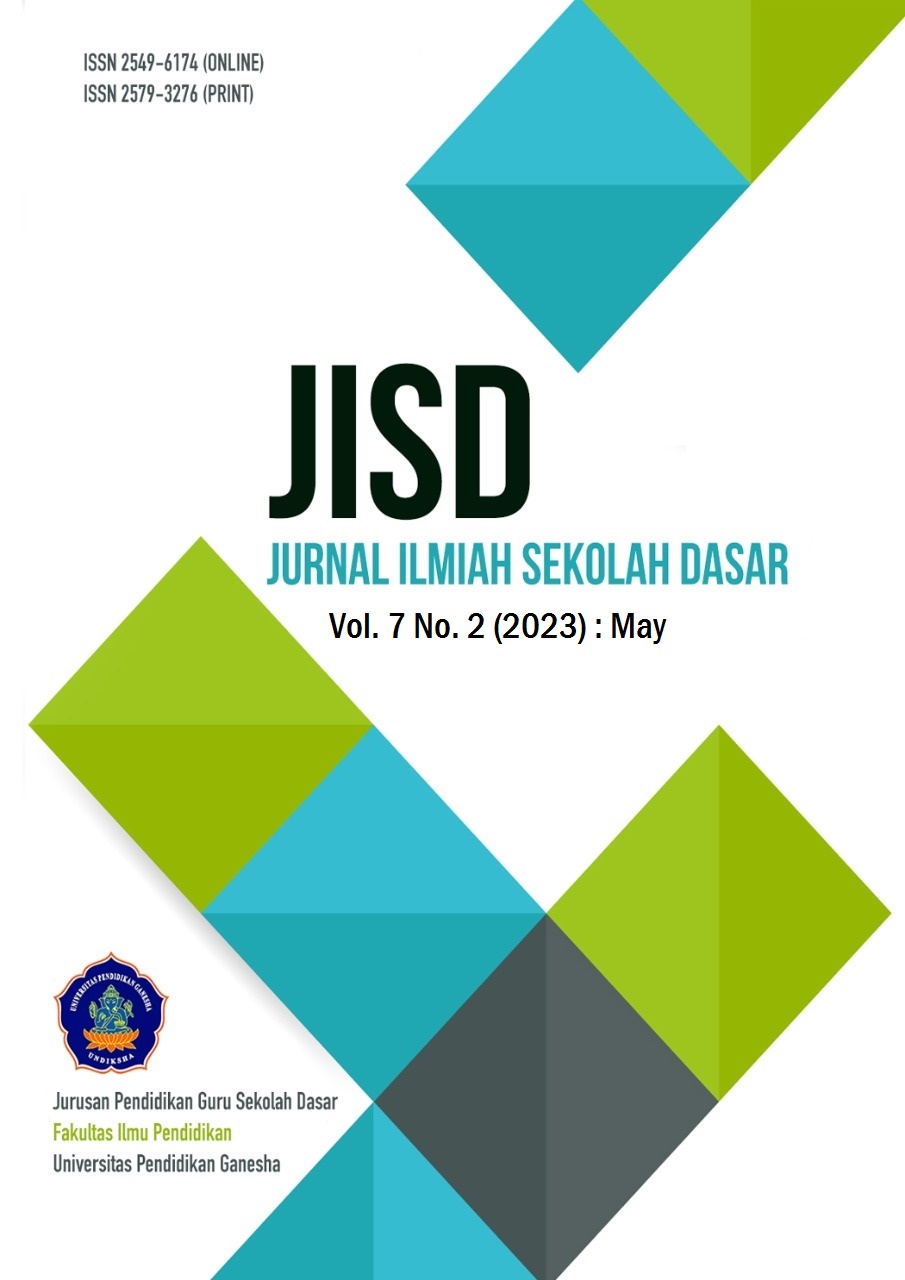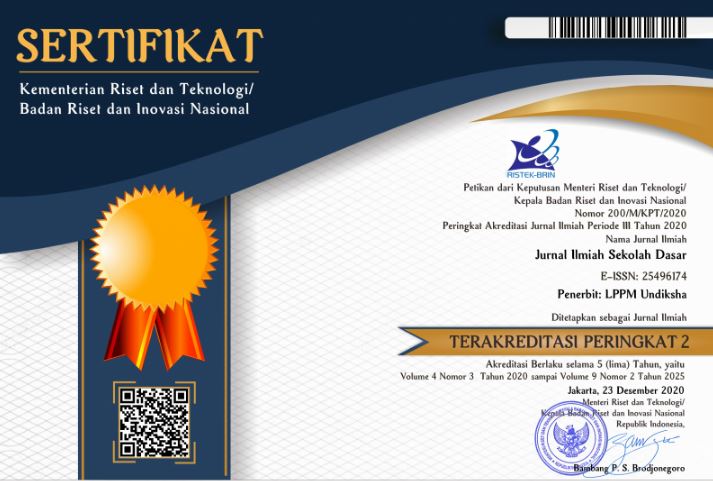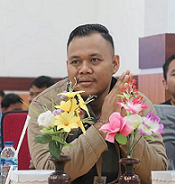Improving Writing a Descriptive Paragraph of Elementary School Students through Picture-Based Mind Mapping
DOI:
https://doi.org/10.23887/jisd.v7i2.54013Keywords:
Mind Mapping, Paragraph DescriptionAbstract
The skill of writing descriptive paragraphs is one of the lessons that are difficult for elementary school students to understand. This study aims to analyze the effect of media image-based mind mapping on the skills of writing descriptive paragraphs of elementary school students. This study used quantitative research with a quasi-experimental design method with a Non-equivalent control group type. In this study, two groups were not randomly selected. Both groups were given a pretest to determine the initial state. The experimental group was treated with image media-based mind mapping, while the control group was image-based. Data collection techniques using observation and test sheets writing descriptive paragraphs. Assessment of the quality of writing descriptive paragraphs is based on focus, development, unity, coherence, and correctness. The collected data will be analyzed through two analyzes, namely descriptive statistical analysis and inferential statistical analysis. The results of the study show that image media-based mind mapping has a significant effect on improving the skills of writing descriptive paragraphs in elementary school students. Image media-based mind mapping inspires students to write because it can develop and describe the ideas they want to write in a clearer and well-structured manner.
References
Allen, H. W., & Paesani, K. (2022). Genre instruction, textual borrowing, and foreign language writing: Graduate teaching assistant perspectives and practices. Language Teaching Research, 26(4), 755–776. https://doi.org/10.1177/1362168820911194. DOI: https://doi.org/10.1177/1362168820911194
Aminatun, D., Ngadiso, N., & Marmanto, S. (2019). Applying PLEASE Strategy to Teach Writing Skill on Students with Different Linguistic Intelligence. TEKNOSASTIK, 16(1), 34–40. https://doi.org/10.33365/TS.V16I1.120. DOI: https://doi.org/10.33365/ts.v16i1.120
Aprinawati, I. (2018). Penggunaan Model Peta Pikiran (Mind Mapping) Untuk Meningkatkan Pemahaman Membaca Wacana Siswa Sekolah Dasar. Jurnal Basicedu, 2(1), 140–147. https://doi.org/10.31004/basicedu.v2i1.35. DOI: https://doi.org/10.31004/basicedu.v2i1.132
Apriyanti, N., Razak, R. A., Shaharom, M. S. N., Rahim, S. S. A., & Halili, S. H. (2020). Needs Analysis of Infographic Media Using Technology for Learning Physics. Malaysian Online Journal of Educational Technology, 8(1), 48–62. https://doi.org/10.17220/mojet.2020.01.004. DOI: https://doi.org/10.17220/mojet.2020.01.004
Azizah, S. (2013). Efektivitas Penggunaan Strategi Mind Mapping Mata Kuliah Writing. NUANSA: Jurnal Penelitian Ilmu Sosial Dan Keagamaan Islam, 10(2). https://doi.org/10.19105/NUANSA.V10I2.175.
Bijami, M., Kashef, S. H., & Khaksari, M. (2013). Gender Differences and Writing Performance: A Brief Review. International Journal of Education and Literacy Studies, 1(2), 8–11. https://doi.org/10.7575/aiac.ijels.v.1n.2p.8. DOI: https://doi.org/10.7575/aiac.ijels.v.1n.2p.8
Buzan, T. (2012). Mind Map. Jakarta: Gramedia Pustaka Utama.
Cahyono, A., Murtono, & Suad. (2022). The Influence Of The Think Pair Share Model And Mind Mapping On Exposition Writing Skills In Terms Of Student Learning Independence Of Teuku Umar Cluster Students. KREDO : Jurnal Ilmiah Bahasa Dan Sastra, 6(1), 102–113. https://doi.org/10.24176/KREDO.V6I1.8398. DOI: https://doi.org/10.24176/kredo.v6i1.8398
Chalkiadaki, A. (2018). A systematic literature review of 21st century skills and competencies in primary education. International Journal of Instruction, 11(3), 1–16. https://doi.org/10.12973/iji.2018.1131a. DOI: https://doi.org/10.12973/iji.2018.1131a
Collins, A., Brown, J. S., & Newman, S. E. (2018). Cognitive apprenticeship: Teaching the crafts of reading, writing, and mathematics. Knowing, Learning, and Instruction: Essays in Honor of Robert Glaser, 453–494. https://doi.org/10.4324/9781315044408-14/cognitive-apprenticeship-teaching-crafts-reading-writing-mathematics-allan-collins-john-seely-brown-susan-newman. DOI: https://doi.org/10.4324/9781315044408-14
Conceição, S. C. O., Samuel, A., & Yelich Biniecki, S. M. (2017). Using concept mapping as a tool for conducting research: An analysis of three approaches. Http://Www.Editorialmanager.Com/Cogentsocsci, 3(1), 1404753. https://doi.org/10.1080/23311886.2017.1404753. DOI: https://doi.org/10.1080/23311886.2017.1404753
Costantino, M. A., & Bonati, M. (2014). A Scoping Review of Interventions to Supplement Spoken Communication for Children with Limited Speech or Language Skills. PLOS ONE, 9(3), e90744. https://doi.org/10.1371/JOURNAL.PONE.0090744. DOI: https://doi.org/10.1371/journal.pone.0090744
Dahliana, D., Taufina, T., Nasrul, S., & Sukandar, W. (2019). Pengaruh Teknik Mind Mapping Terhadap Keterampilan Menulis Puisi Siswa Sekolah Dasar. JINoP (Jurnal Inovasi Pembelajaran), 5(1), 17. https://doi.org/10.22219/jinop.v5i1.6934. DOI: https://doi.org/10.22219/jinop.v5i1.6934
Davies, M. (2011). Concept mapping, mind mapping and argument mapping: what are the differences and do they matter? Higher Education 2010 62:3, 62(3), 279–301. https://doi.org/10.1007/S10734-010-9387-6. DOI: https://doi.org/10.1007/s10734-010-9387-6
de Koning, B. B., & van der Schoot, M. (2013). Becoming Part of the Story! Refueling the Interest in Visualization Strategies for Reading Comprehension. Educational Psychology Review, 25(2), 261–287. https://doi.org/10.1007/S10648-013-9222-6/METRICS. DOI: https://doi.org/10.1007/s10648-013-9222-6
Erdem, A. (2017). Mind Maps as a Lifelong Learning Tool. Universal Journal of Educational Research, 5(12A), 1–7. https://doi.org/10.13189/ujer.2017.051301. DOI: https://doi.org/10.13189/ujer.2017.051301
Fraenkel, J. R., Wallen, N. E., & Hyun, H. H. (2012). How to design and evaluate research in education (8th ed.). The McGraw-Hill Companies.
Fu, Q. K., Lin, C. J., Hwang, G. J., & Zhang, L. (2019). Impacts of a mind mapping-based contextual gaming approach on EFL students’ writing performance, learning perceptions and generative uses in an English course. Computers & Education, 137, 59–77. https://doi.org/10.1016/J.COMPEDU.2019.04.005. DOI: https://doi.org/10.1016/j.compedu.2019.04.005
Gagić, Z. Z., Skuban, S. J., Radulović, B. N., Stojanović, M., & Gajić, O. Đ. (2019). The Implementation Of Mind Maps In Teaching Physics: Educational Efficiency And Students’ Involvement. Journal of Baltic Science Education, 18(1), 117–131. https://www.ceeol.com/search/article-detail?id=950668. DOI: https://doi.org/10.33225/jbse/19.18.117
Galbraith, D., & Baaijen, V. M. (2018). The Work of Writing: Raiding the Inarticulate. Https://Doi.Org/10.1080/00461520.2018.1505515, 53(4), 238–257. https://doi.org/10.1080/00461520.2018.1505515. DOI: https://doi.org/10.1080/00461520.2018.1505515
Gawain, S. (2016). Creative Visualization - 40th Anniversary Edition: Use the Power of Your Life. New World Library.
Gere, A. R., Limlamai, N., Wilson, E., MacDougall Saylor, K., & Pugh, R. (2019). Writing and Conceptual Learning in Science: An Analysis of Assignments. Written Communication, 36(1), 99–135. https://doi.org/10.1177/0741088318804820/ASSET/IMAGES/LARGE/10.1177_0741088318804820-FIG2.JPEG. DOI: https://doi.org/10.1177/0741088318804820
Gilakjani, A. P., Sabouri, N. B., Pourhosein, A., & Branch, L. (2016). Learners’ Listening Comprehension Difficulties in English Language Learning: A Literature Review. English Language Teaching, 9(6), 123–133. https://doi.org/10.5539/elt.v9n6p123. DOI: https://doi.org/10.5539/elt.v9n6p123
Gómez Betancur, M. I., & King, G. (2014). Using mind mapping as a method to help ESL/EFL students connect vocabulary and concepts in different contexts. Trilogía: Ciencia Tecnología Sociedad, 6(10), 69–85. https://dialnet.unirioja.es/servlet/articulo?codigo=4785353. DOI: https://doi.org/10.22430/21457778.439
Graham, S., Gillespie, A., & McKeown, D. (2013). Writing: Importance, development, and instruction. Reading and Writing, 26(1), 1–15. https://doi.org/10.1007/S11145-012-9395-2/METRICS. DOI: https://doi.org/10.1007/s11145-012-9395-2
Graham, S., Liu, X., Bartlett, B., Ng, C., Harris, K. R., Aitken, A., Barkel, A., Kavanaugh, C., & Talukdar, J. (2017). Reading for Writing: A Meta-Analysis of the Impact of Reading Interventions on Writing. Review of Educational Research, 88(2), 243–284. https://doi.org/10.3102/0034654317746927. DOI: https://doi.org/10.3102/0034654317746927
Grégoire, D. A., Cornelissen, J., Dimov, D., & van Burg, E. (2015). The Mind in the Middle: Taking Stock of Affect and Cognition Research in Entrepreneurship. International Journal of Management Reviews, 17(2), 125–142. https://doi.org/10.1111/IJMR.12060. DOI: https://doi.org/10.1111/ijmr.12060
Grünke, M., & Leonard-Zabel, A. M. (2015). How to Support Struggling Writers: What the Research Stipulates. International Journal of Special Education, 30(3), 137–149. https://eric.ed.gov/?id=EJ1095015.
Hayon, J. (2007). Membaca dan Menulis Wacana: Petunjuk Praktis Bagi Mahasiswa. Grasindo.
Hwang, G. J., Shi, Y. R., & Chu, H. C. (2011). A concept map approach to developing collaborative Mindtools for context-aware ubiquitous learning. British Journal of Educational Technology, 42(5), 778–789. https://doi.org/10.1111/J.1467-8535.2010.01102.X. DOI: https://doi.org/10.1111/j.1467-8535.2010.01102.x
Khair, U. (2018). Pembelajaran Bahasa Indonesia dan Sastra (BASASTRA) di SD dan MI. AR-RIAYAH : Jurnal Pendidikan Dasar, 2(1), 81–98. https://doi.org/10.29240/JPD.V2I1.261. DOI: https://doi.org/10.29240/jpd.v2i1.261
Lo, J. J., Yeh, S. W., & Sung, C. S. (2013). Learning paragraph structure with online annotations: An interactive approach to enhancing EFL reading comprehension. System, 41(2), 413–427. https://doi.org/10.1016/J.SYSTEM.2013.03.003. DOI: https://doi.org/10.1016/j.system.2013.03.003
Long, D. J., & Carlson, D. (2011). Mind the Map: How Thinking Maps Affect Student Achievement. Networks: An Online Journal for Teacher Research, 13(2), 262–262. https://doi.org/10.4148/2470-6353.1083. DOI: https://doi.org/10.4148/2470-6353.1083
Lugmayr, A., Stockleben, B., Zou, Y., Anzenhofer, S., & Jalonen, M. (2014). Applying “design Thinking” in the context of media management education. Multimedia Tools and Applications, 71(1), 119–157. https://doi.org/10.1007/S11042-013-1361-8/METRICS. DOI: https://doi.org/10.1007/s11042-013-1361-8
Malekian, F., Pour, A. R. F., & Pour, B. S. (2012). Study the Effect of Supplemental Instructional Images on Students’ Spatial Intelligence Degree. Procedia - Social and Behavioral Sciences, 46, 3301–3305. https://doi.org/10.1016/J.SBSPRO.2012.06.055. DOI: https://doi.org/10.1016/j.sbspro.2012.06.055
Marita, S., Hord, C., & Hendricks, J. (2021). Using visual strategies simultaneously to support students with learning disabilities in mathematics. Support for Learning, 36(3), 327–341. https://doi.org/10.1111/1467-9604.12365. DOI: https://doi.org/10.1111/1467-9604.12365
McGinley, W., Kamberelis, G., & White, J. W. (2020). Exploring selves and worlds through affective and imaginative engagements with literature. Educational Philosophy and Theory, 1–13. https://doi.org/10.1080/00131857.2020.1785285. DOI: https://doi.org/10.1080/00131857.2020.1785285
Millis, B. J. (2006). Helping Faculty Learn to Teach Better and “Smarter” Through Sequenced Activities. To Improve the Academy, 24(1), 216–230. https://doi.org/10.1002/J.2334-4822.2006.TB00460.X. DOI: https://doi.org/10.1002/j.2334-4822.2006.tb00460.x
Mingli, L. (2019). Using Mind Maps to Develop English Majors’ Essay Writing in China. Sino-US English Teaching, 16(10), 419–425. https://doi.org/10.17265/1539-8072/2019.10.003. DOI: https://doi.org/10.17265/1539-8072/2019.10.003
Murray, & Rockowitz, A. C. (2019). THE WRITING PROCESS Five Qualities of Good Writing FIVE QUALITIES OF GOOD WRITING FOCUS. Hunter Rockowitz Writing Center.
Pallotti, G. (2014). A simple view of linguistic complexity. Second Language Research, 31(1), 117–134. https://doi.org/10.1177/0267658314536435. DOI: https://doi.org/10.1177/0267658314536435
Perumal, K., & Ajit, I. (2020). Enhancing Writing Skills: A Review. PSYCHOLOGY AND EDUCATION, 57(9), 2229–2236. https://doi.org/10.17762/pae.v57i9.592.
Poldrack, R. A., & Yarkoni, T. (2016). From brain maps to cognitive ontologies: informatics and the search for mental structure. Annual Review of Psychology, 67, 587. https://doi.org/10.1146/ANNUREV-PSYCH-122414-033729. DOI: https://doi.org/10.1146/annurev-psych-122414-033729
Putrayasa, I. B. (2015). Pembelajaran Menulis Paragraf Deskripsi Berbasis Mind Mapping Pada Siswa Kelas Vii Smp Laboratorium Undiksha. JPI (Jurnal Pendidikan Indonesia), 4(2), 2303–288. https://doi.org/10.23887/JPI-UNDIKSHA.V4I2.6060. DOI: https://doi.org/10.23887/jpi-undiksha.v4i2.6060
Qin, W., & Uccelli, P. (2021). Textual borrowing in science summaries: upper-elementary and middle school students learning to write the language of science. Reading and Writing, 34(10), 2505–2528. https://doi.org/10.1007/S11145-021-10155-4. DOI: https://doi.org/10.1007/s11145-021-10155-4
Ramadhanti, D., & Yanda, D. P. (2021). Students’ Metacognitive Awareness and Its Impact on Writing Skill. International Journal of Language Education, 5(3), 193–206. https://doi.org/10.26858/ijole.v5i3.18978. DOI: https://doi.org/10.26858/ijole.v5i3.18978
Ritchhart, R., Turner, T., & Hadar, L. (2009). Uncovering students’ thinking about thinking using concept maps. Metacognition and Learning, 4(2), 145–159. https://doi.org/10.1007/S11409-009-9040-X/METRICS. DOI: https://doi.org/10.1007/s11409-009-9040-x
Riyanton, M., Kariadi, M. T., Krisnawati, V., Martha, N. U., & Setiani, U. A. (2021). Whole language as a language learning approach. Proceedings of the International Conference on Industrial Engineering and Operations Management, 11(7), 3746–3755. http://www.ieomsociety.org/singapore2021/papers/679.pdf.
Roelfsema, P. R., Denys, D., & Klink, P. C. (2018). Mind Reading and Writing: The Future of Neurotechnology. Trends in Cognitive Sciences, 22(7), 598–610. https://doi.org/10.1016/J.TICS.2018.04.001. DOI: https://doi.org/10.1016/j.tics.2018.04.001
Saharah, S., & Indihadi, D. (2019). Penggunaan Teknik Mind Mapping pada keterampilan Menulis Ringkasan Siswa dalam Pembelajran Bahasa Indonesia. PEDADIDAKTIKA: Jurnal Ilmiah Pendidikan Guru Sekolah Dasar, 6(1), 9–15. https://doi.org/10.17509/pedadidaktika.v6i1.12610.
Sahiti, Q., & Stamp, J. A. (2022). The Use of Visuals in Undergraduate Neuroscience Education: Recommendations for Educators. Teaching of Psychology, 49(3), 276–283. https://doi.org/10.1177/00986283211000326. DOI: https://doi.org/10.1177/00986283211000326
Santangelo, T. (2014). Why Is Writing so Difficult for Students with Learning Disabilities? A Narrative Review to Inform the Design of Effective Instruction. Learning Disabilities: A Contemporary Journal, 12(1), 5–20. https://eric.ed.gov/?id=EJ1039858.
Schaafsma, S. M., Pfaff, D. W., Spunt, R. P., & Adolphs, R. (2015). Deconstructing and reconstructing theory of mind. Trends in Cognitive Sciences, 19(2), 65–72. https://doi.org/10.1016/J.TICS.2014.11.007. DOI: https://doi.org/10.1016/j.tics.2014.11.007
Schallert, D. L. (2017). The role of illustrations in reading comprehension. Theoretical Issues in Reading Comprehension: Perspectives from Cognitive Psychology, Linguistics, Artificial Intelligence and Education, 503–524. https://doi.org/10.4324/9781315107493-27/role-illustrations-reading-comprehension-diane-lemonnier-schallert. DOI: https://doi.org/10.4324/9781315107493-27
Schroeder, N. L., Nesbit, J. C., Anguiano, C. J., & Adesope, O. O. (2018). Studying and Constructing Concept Maps: a Meta-Analysis. Educational Psychology Review, 30(2), 431–455. https://doi.org/10.1007/S10648-017-9403-9/METRICS. DOI: https://doi.org/10.1007/s10648-017-9403-9
Selim Bayburtlu I Teacher, Y. (2020). Improving the Skills of Writing a Thought Paragraph in 7th Grade Students: An Action Research Study. Online Submission, 7(5), 55–81. https://doi.org/10.5281/zenodo.3835161.
Sofyan, A., Yudistira, R., Muta’allim, Alfani, F. R., & Ghaffar, A. A. (2022). The analysis of conversational implicature between students and teachers at Al-Azhar Islamic boarding school. RETORIKA: Jurnal Ilmu Bahasa, 8(1), 65–72. https://doi.org/10.55637/jr.8.1.4042.65-72. DOI: https://doi.org/10.55637/jr.8.1.4042.65-72
Supriadi, Sani, A., & Setiawan, I. P. (2020). Integrasi Nilai Karakter dalam Pembelajaran Keterampilan Menulis Siswa. YUME : Journal of Management, 3(3), 84–94. https://doi.org/10.2568/YUM.V3I3.828.
Vejayan, L., Yunus, M. M., Vejayan, L., & Yunus, M. M. (2022). Application of Digital Mind Mapping (MINDOMO) in Improving Weak Students’ Narrative Writing Performance. Creative Education, 13(8), 2730–2743. https://doi.org/10.4236/CE.2022.138172. DOI: https://doi.org/10.4236/ce.2022.138172
Vera, B., & Satriani, I. (2019). The Use of Cooperative Learning and Discovery Learning in Teaching Writing Descriptive Text. Journal of English Language Learning, 3(2). http://www.jurnal.unma.ac.id/index.php/JELL/article/view/1561.
Williams, C., & Beam, S. (2019). Technology and writing: Review of research. Computers & Education, 128, 227–242. https://doi.org/10.1016/J.COMPEDU.2018.09.024. DOI: https://doi.org/10.1016/j.compedu.2018.09.024
Downloads
Published
How to Cite
Issue
Section
License
Copyright (c) 2023 Tarman A Arief, Arwan Wiratman

This work is licensed under a Creative Commons Attribution-ShareAlike 4.0 International License.
Authors who publish with the Journal Ilmiah Sekolah Dasar agree to the following terms:
- Authors retain copyright and grant the journal the right of first publication with the work simultaneously licensed under a Creative Commons Attribution License (CC BY-SA 4.0) that allows others to share the work with an acknowledgment of the work's authorship and initial publication in this journal.
- Authors are able to enter into separate, additional contractual arrangements for the non-exclusive distribution of the journal's published version of the work (e.g., post it to an institutional repository or publish it in a book), with an acknowledgment of its initial publication in this journal.
- Authors are permitted and encouraged to post their work online (e.g., in institutional repositories or on their website) prior to and during the submission process, as it can lead to productive exchanges, as well as earlier and greater citation of published work. (See The Effect of Open Access)










